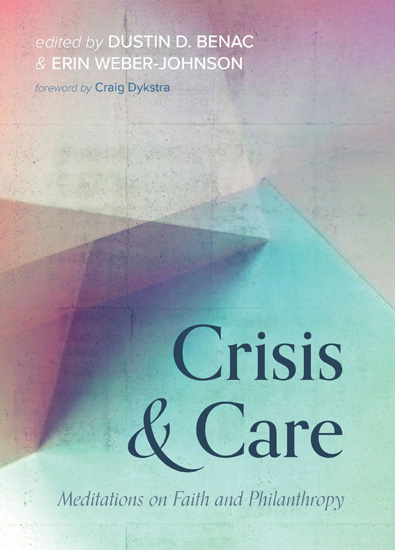In the 16th century, Martin Luther wrote of the three conversions necessary for the Christian life: the conversion of the heart, the conversion of the mind and the conversion of the purse. That Luther left money for last may indicate that he knew how stubborn even the gentlest souls can be when it comes to personal finances -- though at least he was willing to bring up a topic that many church leaders consider the third rail of pastoring.
On the other hand, Luther was writing at the start of a reformation, not the beginning of a recession. Even he might have trouble figuring out how to broach the topic of stewardship at a time when so many congregants are struggling economically and fearful of the future. Yet church leaders and other experts say that the current situation presents -- odd as it may sound -- genuine opportunities to reconsider the usual approach to Christian giving in hopes of transforming attitudes toward money and church.
“Part of what makes a good steward is managing your expenses,” said the Rev. Ed Kruse, director for stewardship for the Evangelical Lutheran Church in America. But, Kruse added, “Any time you only look at cutting, you are only dealing with a half-truth. You also need to look at generating increased giving.”
Questions to consider
Questions to consider:
- What does your method for appealing for money say about your theological convictions?
- What criteria do you use to sort through conflicting opinions about the most effective way to raise money?
- How does one live and lead through the tension of trusting in God’s provision while watching the bottom line?
- What is your mission? Who can help you imagine the untapped resources needed to work toward that mission?
Yet asking people to give can seem harder than ever. Church experts and consultants offer many fundraising tips and strategies, many of them contradicting each other and making it as confusing as the latest diet plan or workout regimen. Some advocate pledging specific amounts; others say envelopes send the wrong signal. Some promote tithing at a 10 percent level; others say that strategy scares people off. In addition, different approaches will work better for some congregations than others and in one denomination better than another.
“Changing the model is definitely a risk,” said Sylvia Ronsvalle, executive vice-president of empty tomb, inc., a leading research institute on stewardship and church giving patterns. “It’s totally unpredictable. But clearly the current model doesn’t leave the church well-suited for tough times.”
But history also shows that the church responded creatively during the Great Depression and the downturn of the 1970s, finding new ways to serve as well as to raise funds, said James Hudnut-Beumler, a historian of American religion and dean of the Divinity School at Vanderbilt University.
Severe economic contractions can lead to long-term shifts in the practices of believers, he said.
“Is there a potential for a return to some kind of Christian solidarity out of this?” he asked. “Or will we just revert to a market-client kind of consumer Christianity? I think nothing changes completely overnight. However, the longer this lasts, the more it will change us in a fundamental way.”
The important part is to ground a congregation’s understanding of giving in Scripture and in the context of spiritual growth, both individually and communally. “It is totally a spiritual journey,” Kruse said. “It’s not about fundraising. It’s about ‘faith-raising.’”
Honest talk in tough times
Talking about money makes everyone uncomfortable. Yet the authors of a 2008 book, “Passing the Plate: Why American Christians Don’t Give Away More Money,” found that, generally, Christians gave money when asked, and they didn’t feel they were being asked for too much. But if they weren’t asked, they didn’t give or didn’t give as much.
Kerry Robinson, executive director of the National Leadership Roundtable on Church Management, a non-profit that focuses on fostering better financial practices in the Roman Catholic Church, said church leaders across denominations tend to share a theological ambivalence about money. This impedes their ability to talk about finances even when the funds are to help carry out God’s work, she said.
While asking, “What would Jesus do?” can sound like a cliché, experts say Christ did set the example, even if those Gospel passages are the ones many Christians would rather skim. And Ronsvalle, of empty tomb, inc., noted that when Jesus spoke about sacrificing material things, he usually was talking to those who were themselves poor.
“He did not shy away from the fact that you need to be giving people, you need to care about others,” Ronsvalle said. “Here you’ve got 5,000 people, and you have to feed them. He says sell what you have and give to the poor. He’s talking to the poor!”
For all the clarity and power of the Gospel stories, however, Christians weigh Jesus’ injunctions against the “kitchen table” concerns they find when they get home from church. They also contend with the cultural influence of American individualism and the reverence for freedom in the marketplace as well as the sanctuary. For many believers, experts say, donations are best when they are ad hoc, free-will offerings, a spontaneous act of faith and not part of a “program.”
Indeed, the Faith Communities Today (FACT) survey from the Hartford Seminary’s Institute for Religious Research found that even before the recession, the most frequently cited cause of conflict in American congregations was money. A 2005 update of the survey also found that congregational finance was among the top five challenges for churches. And it is likely no coincidence that the 2005 FACT report showed the percentage of congregations that rated their financial condition as “good or excellent” dropped from 66 percent in 2000 to 57 percent. Experts say the level of economic confidence in congregations is most certainly lower today given the onset of the recession.
As always, different church communities will experience the effects of the downturn in different ways and with varying degrees of pain. Research has consistently shown that rates of giving range widely, with Catholics giving less than 3 percent of their income to religious institutions, and Pentecostals and evangelicals giving 7 or 8 percent or more. Mainline Protestants fall somewhere in the middle. On the other hand, while wealthier, evangelical-style megachurches with a strong tradition of tithing may weather the economic storm reasonably well, experts say these congregations also can find themselves overextended due to ambitious building projects.
Feeling the pinch
Like everyone else with bills to pay and debts to manage, church leaders are watching their income anxiously.
History and research offer some guidance, though much about the current downturn and its effects remains unknown and perhaps unknowable. Ronsvalle pointed to statistics showing that from 1968 to 2005, giving did not always go down in recession years.
“Data from the last six recessions show mixed results -- in three of the recessions giving declined, while in three it increased -- but only in 1970 did giving go down in the first year of the recession,” she said. “So if it’s been unpredictable in the past, I think it is going to be this time, too.”
A decline in most congregations is already happening in many places, forcing cutbacks in staff and programs. In Portland, Ore., for example, the First Unitarian Church is closing down for the month of July to try to close a $185,000 budget gap.
“The congregation needs to own the problems and understand the consequences,” the Rev. Marilyn Sewell, senior pastor, said in a Jan. 25 announcement and letter to the church's 1,500 members. Sewell told Religion News Service the church usually expects about 4 percent of pledges to go unpaid. But this year, about 10 percent of pledges are unpaid, and fewer families are pledging. “I was hoping for more of a vigorous response from people who haven't pledged,” Sewell told RNS. “But fear is a powerful force right now. People are thinking, ‘Wait and see -- it may be even worse than we can imagine’.”
The full extent of the impact likely will not become clear until next year.
“The first thing that happens is that people honor the commitments they made just as much as they can during the year they made them,” said Hudnut-Beumler, who is author of the 2007 book, “In Pursuit of the Almighty’s Dollar: A History of Money and American Protestantism.” “So if the economy tanks in March, they still make their budgets until the end of that year.”
Early indicators may be reinforcing that thesis. A January report by the Evangelical Council for Financial Accountability showed that while most evangelical parachurch ministries met their contribution goals at the end of 2008, they weren’t counting on that holding up. “Most ECFA member ministries expect 2009 to be more challenging, primarily because major donors who made gifts in 2008 have expressed they may not be able to renew their financial commitments because of the economy,” said Dan Busby, acting ECFA president.
And there is no guarantee that 2010 will be any better. While church giving often remained high for the first year or two of an economic downturn, Hudnut-Beumler noted that giving also was slower to recover than the economy overall.
“And that pattern has repeated itself at least since the panics of the 1890s,” he said. Moreover, economic downturns tend to depress clergy and church worker compensation longer than other fields, which, in turn, also hurts ministry.
Asking for sacrifice
In this context, it becomes even more important to bring understanding and sophistication to discussions about giving.
Robinson said that when she became involved in fundraising and stewardship education, she was struck by the violent terminology people used to describe her work, including “hit you up” or “take a bite out.” “It is the language of violation rather than what it should more properly be,” Robinson said. “There is an overtone of manipulation and deceit. None of that is helpful. If that is how you approach it, you’ll never be successful.”
Often when they do raise the topic of money, church leaders frame fundraising requests in terms of a personal favor rather than an offering for the community and a life-giving mission. This is a reflection of the ambivalence that church leaders feel but sends the wrong message, Robinson said.
“Money tends to be equated with the temporal side of things,” Robinson said. “There’s a dichotomy they’ve placed between mission and ministry and vocation and pastoral presence -- and this ‘other,’ which is the day-to-day management and finances.”
Experts also say that for churches that find themselves in a bind, “crisis-oriented” fundraising can work, at least in the short term. But crisis fundraising does not cultivate real Christian discipleship, nor is it the best practical solution for the long-term -- or even in the months ahead.
It might even backfire with people who feel their personal finances are troubled. “The difficulty is that people are saying, ‘You want crisis? I’ve got crisis,’” Ronsvalle said.
Stressing more systematic giving, such as tithing, prompts mixed responses. Even the word tithing -- the tradition of dedicating a set portion of one’s income, as much as 10 percent, for church -- may have negative connotations, and some prefer terms like “proportional giving” or “graduated tithing.”
Whichever words are used, the concept always will include an aspect of sacrifice because sacrifice is integral to Christianity. The key in tough times, Kruse said, is to emphasize general principles about stewardship and to respond to each particular situation pastorally. Congregants never should be made to feel guilty if they have to reduce their donations. Giving out of guilt only induces resentment, and it hardly makes for a “cheerful giver” who is donating out of thankfulness and the love of God and neighbor, he said.
Kruse recalled how he and his wife decided to increase their giving at a time when they were going from two incomes to one. But they decided they wouldn’t feel legalistically bound to a specific amount, and would reduce it if that amount caused them genuine hardship. “One of the things we said to each other was that if this turns out to be a hardship, the gospel trumps the law,” he said.
Grounded in the mission
Kruse and others also agreed on two points that help frame stewardship for Christians of any income level. One is to ground giving in the church’s mission, talking specifically about the way in which the donors’ money will be used.
“I always say that the starting point is to be clear what your mission is,” Robinson said. “And it turns out that not everybody is clear about it, which is part of the problem. But when you are clear about it, you bring this confidence and passion and joy to advancing that mission.”
“Money follows mission,” she added. This focus on mission will shift the language of the conversation from “fundraising” to identity and creativity.
“Suddenly stewardship isn’t regarded just as proper care of what has been entrusted to you, but also a recognition and proper care of the potential at hand, and bringing new life into fruition,” Robinson said. “There has to be that constant generative evaluation and assessment. That’s the difference between maintenance and mission. Maintenance is so seductive and easy, because people are tired.”
The second point is to direct the focus of giving to helping others, whether inside or outside one’s own church.
In the current crisis, many economists are reaching back to the Great Depression for instructive parallels, Hudnut-Beumler said.
In the stock market crisis of the 1930s and the energy crisis of the 1970s, American congregations initially stuck with tried-and-true fundraising efforts, but they weren’t effective, he said.
Simply asking people to put more money in the collection plate or raise their pledges didn’t work. What did work -- and what impressed Hudnut-Beumler during his research -- was how churches quickly shifted gears. In the 1930s cash was so tight that churches started food banks and encouraged bartering, or turned their halls into shelters, anything to get folks through the hard times. “The solidarity and love that came out of those kinds of church experiences in small towns all across this country is part of that whole ‘greatest generation’ ethos,” he said.
Similarly, in the 1970s many urban churches began looking at their buildings not as structures “to be preserved for Sunday morning” but as multi-use facilities that would open their doors for social programs the other six days of the week. By reaching out to others, congregations saved -- and transformed -- themselves.
“What tends to work pastorally,” said Hudnut-Beumler, who is a Presbyterian minister, “is to talk up what we do well in sunshine and in rain. What the budget does is allow us to collectively contribute to acts of mercy, justice and hospitality on behalf of God and the people of God right here and now.”
The irony is that mission can become clearer in a crisis, and undiscovered resources emerge to fulfill that mission. “And sometimes if you can discover your soul as a congregation you’ll have enough between some continued giving and human resources you weren’t tapping into before because everyone was busy,” he said. “Then you’ll have enough total resources to nourish the soul that sustains the body of the church.”
Robinson agreed. “I look at these dire economic times and this legitimately anxious period we’re in as an even greater moment to exercise development and stewardship in these terms. The stakes are higher. People are anxious. They want good news, and they want to contribute in a meaningful way, they want to be selfless. Our faith communities have an opportunity to offer that to others.”
Every organization has its own needs and philosophy around money. These resources offer some basic strategies for navigating the financial crisis.











